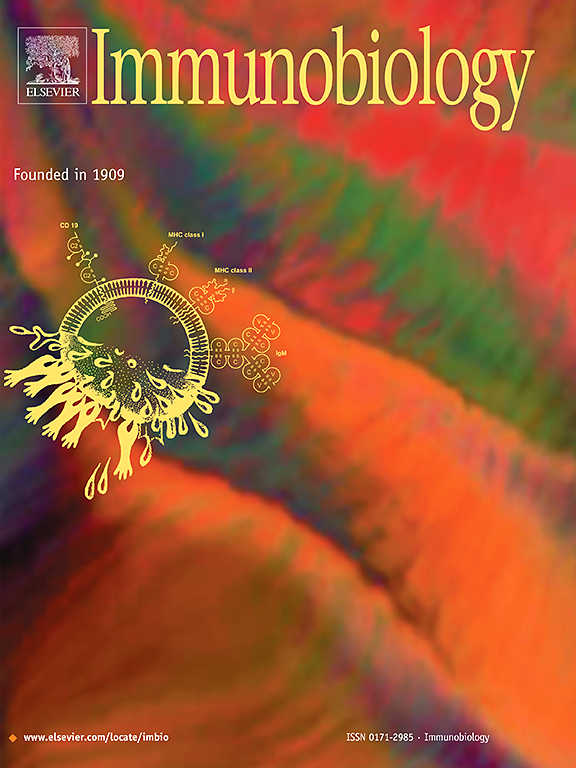Mitochondrial DNA from endothelial cells activated the cGAS-STING pathway and regulated pyroptosis in lung ischaemia reperfusion injury after lung transplantation
IF 2.3
4区 医学
Q3 IMMUNOLOGY
引用次数: 0
Abstract
Objective
Cell dysfunction and death induced by lung ischaemia–reperfusion injury (LIRI) are the main causes of death in transplant patients. Activation of the cGAS-STING-induced immune response and death plays a critical role in multiple organ injuries. However, no study has yet investigated the role of the cGAS-STING pathway in LIRI after lung transplantation.
Methods
Sprague-Dawley (SD) rats were subjected to left lung transplantation and administered inhibitors of cGAS and STING. The expression of cGAS-STING-TBK1-IRF3, histological injury, pulmonary permeability, and the levels of cytokines and pyroptotic proteins in transplanted lungs were tested. Endothelial cells were subjected to hypoxemia and reoxygenation and treated with inhibitors of cGAS and STING. Mitochondrial DNA (mtDNA), the cGAS-STING axis and cytokine levels in cells, cellular activity and death were evaluated. Moreover, after the administration of deoxyribonuclease (DNase) I, the reoxygenated endothelial cells were also examined for cellular function and inflammatory factor expression. Finally, we administered an agonist of STING and an inhibitor of cathepsin B to the normal endothelium and investigated pyroptosis and pyroptotic proteins.
Results
After 24 h of reperfusion, the expression of cGAS-STING-TBK1-IRF3 and pyroptotic proteins was significantly increased, and inhibitors of cGAS or STING ameliorated lung injury and reduced pyroptotic protein levels. In vitro, the inhibition of cGAS and STING reduced the activation of TBK and IRF3 and reduced cellular injury and death. The activation of cGAS-STING and cellular inflammation were suppressed by DNase I. Cathepsin B and NLRP3 were upregulated by an agonist of STING, and an inhibitor of cathepsin B reduced NLRP3 levels.
Conclusion
cGAS-STING participated in LIRI by promoting endothelial cell pyroptosis via cathepsin B.

内皮细胞线粒体DNA激活cGAS-STING通路,调控肺移植后肺缺血再灌注损伤的焦亡。
目的:肺缺血再灌注损伤(LIRI)所致的细胞功能障碍和死亡是移植患者死亡的主要原因。激活cgas - sting诱导的免疫反应和死亡在多器官损伤中起关键作用。然而,尚未有研究调查cGAS-STING通路在肺移植术后LIRI中的作用。方法:SD大鼠左肺移植后给予cGAS和STING抑制剂。检测移植肺组织cGAS-STING-TBK1-IRF3的表达、组织损伤、肺通透性、细胞因子和焦亡蛋白水平。内皮细胞进行低氧血症和再氧化,并使用cGAS和STING抑制剂处理。观察线粒体DNA (mtDNA)、细胞内cGAS-STING轴和细胞因子水平、细胞活性和死亡情况。此外,在给予脱氧核糖核酸酶(DNase) I后,还检测了再氧化内皮细胞的细胞功能和炎症因子的表达。最后,我们给正常内皮注射了STING激动剂和组织蛋白酶B抑制剂,并研究了焦亡和焦亡蛋白。结果:再灌注24 h后,cGAS-STING- tbk1 - irf3及焦亡蛋白表达显著升高,cGAS或STING抑制剂可改善肺损伤,降低焦亡蛋白水平。在体外,抑制cGAS和STING可降低TBK和IRF3的激活,减轻细胞损伤和死亡。dna酶i可抑制cGAS-STING的激活和细胞炎症。STING激动剂可上调组织蛋白酶B和NLRP3水平,组织蛋白酶B抑制剂可降低NLRP3水平。结论:cGAS-STING通过组织蛋白酶B促进内皮细胞焦亡参与LIRI。
本文章由计算机程序翻译,如有差异,请以英文原文为准。
求助全文
约1分钟内获得全文
求助全文
来源期刊

Immunobiology
医学-免疫学
CiteScore
5.00
自引率
3.60%
发文量
108
审稿时长
55 days
期刊介绍:
Immunobiology is a peer-reviewed journal that publishes highly innovative research approaches for a wide range of immunological subjects, including
• Innate Immunity,
• Adaptive Immunity,
• Complement Biology,
• Macrophage and Dendritic Cell Biology,
• Parasite Immunology,
• Tumour Immunology,
• Clinical Immunology,
• Immunogenetics,
• Immunotherapy and
• Immunopathology of infectious, allergic and autoimmune disease.
 求助内容:
求助内容: 应助结果提醒方式:
应助结果提醒方式:


